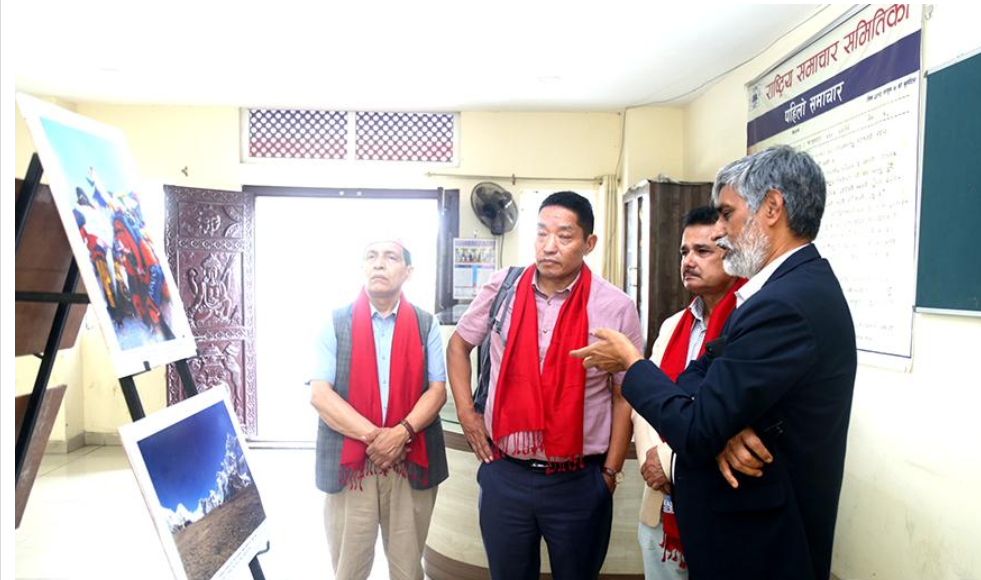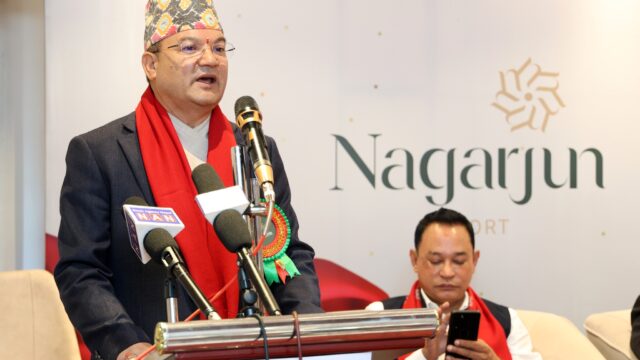Nima Nuru Sherpa, President of the Nepal Mountaineering Association (NMA), has expressed confidence that a photo exhibition organized by the Rastriya Samachar Samiti (RSS) will significantly contribute to the promotion of mountain tourism in Nepal. Sherpa made this remark while observing the photo exhibition titled “Mountain Tourism: Our Pride, Our Identity,” held on the occasion of the 18th Republic Day of Nepal.
Following his visit to the exhibition, President Sherpa stated that the visuals displayed were so compelling that they could inspire anyone to travel to those destinations. “Viewing the photographs gives one an instant urge to visit the places depicted. It creates a lasting impression that makes one want to go back again and again,” he remarked. “The exhibition encompasses the captivating Himalayan regions from east to west. The photo collection is remarkably curated. I sincerely thank the RSS team for organizing such a significant exhibition and giving us the opportunity to witness it.”
Photo Exhibition by RSS
Sherpa emphasized that the images offer more than visual appreciation, they provide viewers with a virtual experience of the mountains, simulating the feeling of being there in person. He asserted that this kind of presentation plays a vital role in strengthening the overall tourism promotion of the country. “So far, we have merely spoken about our mountains and acknowledged their importance verbally,” Sherpa said. “Now is the time to further develop and promote these mountains as structured tourist destinations. The government should invest in expanding road connectivity, air transport links, and basic tourism infrastructure around mountain destinations. If that happens, Nepal’s future in tourism is indeed promising.”
President Sherpa also acknowledged RSS’s meaningful contribution in highlighting mountain and mountaineering-related activities. He extended heartfelt thanks on behalf of NMA, the larger Himalayan community, and himself personally for the initiative.
The exhibition, which opened on May 24 (Jestha 11), features a total of 96 photographs that showcase diverse aspects of the Himalayan region, from striking mountain ranges and pristine snow-capped peaks to the vibrant daily life of Himalayan communities. The images span Nepal’s entire mountain belt, portraying everything from adventure tourism sites to cultural richness.
Alongside Sherpa, NMA General Secretary Mohan Lamsal also praised the initiative. He said, “The role played by RSS in promoting mountain tourism through this photo exhibition is truly commendable. Our NMA team felt a sense of pride when invited to witness these photographs that so vividly portray the essence of mountain tourism.” Lamsal further proposed that similar events could be jointly organized by institutions like NMA and RSS in the future. “I wholeheartedly appreciate this remarkable effort by RSS,” he added.
Senior Vice President of NMA, Thakur Raj Pandey, also accompanied Sherpa and Lamsal during the visit to the RSS central office for the exhibition. All of them lauded the initiative for its capacity to foster deeper public connection with Nepal’s mountain heritage.
Meanwhile, Executive Chairman of RSS, Dharmendra Jha, highlighted the broader significance of the photo exhibition. He noted that the imagery not only celebrates the grandeur of Nepal’s Himalayas but also helps communicate their importance to the national identity. “There’s a common perception that not much has been achieved after the advent of republicanism in Nepal,” Jha remarked. “This exhibition helps to counter that narrative by presenting how Nepal’s natural assets can be celebrated and promoted effectively.”
Jha further noted that visual storytelling can be a powerful tool in tourism promotion, and such exhibitions can serve as inspiration for policymakers and stakeholders to invest in the country’s high-altitude tourism potential.
The RSS exhibition aligns with national efforts to rejuvenate the tourism industry post-COVID-19 and amid changing global travel trends. By focusing on mountain destinations, often regarded as Nepal’s prime attractions, the initiative has sparked renewed dialogue about the need to balance tourism development with environmental preservation and local engagement.
The NMA delegation’s visit and their enthusiastic response underscore the strategic importance of such cultural initiatives. Through exhibitions like this, the Himalayan landscapes are not only visually celebrated but also reintroduced to a new generation of tourists, planners, and policymakers as living, evolving destinations that hold immense potential for sustainable economic growth.
As Nepal continues to position itself as a premier adventure and nature tourism destination, collaborative efforts between governmental agencies like RSS and sectoral institutions like NMA will be essential in shaping a vibrant, inclusive, and globally competitive tourism future.
The exhibition remains open for public viewing at the RSS Central Office, and organizers expect an increasing number of visitors in the coming days. It stands as a timely reminder of Nepal’s unmatched natural wealth and the stories waiting to be told from its majestic mountains.






